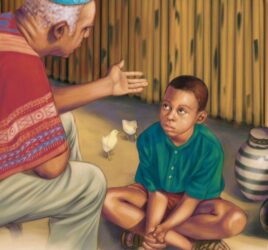Unprecedented migration is a global reality of the twenty-first century. The International Organization for Migration (IOM) dubbed 2015 “The Year of the Migrant.” In the last decade, research on and response to migration has become a priority for nations and communities. More recently, mission organizations, denominations, and congregations have rallied to locally address migrants.
Almost a decade ago, during the Lausanne Movement’s Bi-Annual Leadership Conference in Hungary, Ralph Winter reflected on the seeming imminence of a “borderless world”1: “The world that we now live in has become borderless… In 1974 the political climate was very different—it was the age of the Cold War, “state dictatorship,” and many “closed doors.” (personal communication, June 22, 2007)
As I ponder on the recent surge of national movements on the international stage, and ensuing proposals to “build walls” to curtail flows of migration, I look back on this conversation with Dr. Winter with gratitude for the all-encompassing embrace of the Creator-Redeemer God and with renewed hope in the ‘borderless’ reach of his Church. Below, I suggest ways for local churches to remain hubs of connection, and how they can be actively involved in tearing down walls that separate.
Old Reality, New Opportunity
The historical evidence and biblical examples2 of migration as a reality of human existence abound, thus “migration is not a new problem to be solved, but rather a reality to be managed” (Swing 2015). Hein de Haas, professor of sociology at University of Amsterdam, describes migration as an “intrinsic part of a broader development process” (de Haas 2016). Undoubtedly, human scattering has impacted all communities, countries, and regions throughout history.
From a theological perspective, Luis Pantoja Jr., the late Filipino-American theologian, writes in the seminal diaspora missiology volume Scattered: the Filipino Global Presence: “Humankind is designed for mobility and conquest… mobility is endemic to human nature. People reside in or move from one place to another because God made them with such instincts” (Pantoja 2004, 81). At the Third Lausanne Congress in Cape Town, the Lausanne Diasporas Leadership Team affirmed:
The fact is that God created nations (Genesis 25:23; Psalm 86:9-10) and languages/cultures (Genesis 11:1, 6, 7, 9), and determined the place (space) and the timing (time) of our habitation. The passage in Acts 17:26-29 implies that He not only “uses” the “diasporas;” but designs, conducts, and employs such “diasporas” for His own glory, the edification of His people, and the salvation of the lost. Every dispersed person and people group has a place and a role to play in God’s redemptive history. (LDLT 2010b, 12)
International migration continuously affects demographic distribution, economies, structures, and cultures globally. Currently, mass migration is driven primarily by “demography; disasters; the digital revolution; distance-shrinking technology; north-south disparities; and environmental degradation” (Swing, 2016).
In the publication Trends in Total Migrant Stock: The 2015 Revision, the Population Division of the Department of Economic and Social Affairs of the United Nations Secretariat reports that “The number of international migrants—persons living in a country other than where they were born—reached 244 million in 2015 for the world as a whole, a 41 percent increase compared to 2000” (UNESA 2015, 1). This includes “almost 20 million refugees” (UNSD 2016) and ten million stateless people who are denied a nationality (UNHCR 2016).
Further, the report states that:
In 2015, two thirds (67 per cent) of all international migrants were living in just twenty countries. The largest number of international migrants (47 million) resides in the United States of America… Germany and the Russian Federation host the second and third largest numbers of migrants worldwide (12 million each), followed by Saudi Arabia (10 million), the United Kingdom of Great Britain and Northern Ireland (nearly 9 million), and the United Arab Emirates (8 million). (UNESA 2015)
Although not a new reality, migration’s colossal increase presents a complex challenge and urgent opportunity for the Church. While government agencies, aid organizations, and community institutions grapple with the effects of modern population movements, missiologists, denominations, and local churches scramble to respond with sensitivity and relevance to God’s movement through the scattering of humans at this time in history.
Defining Diaspora Missiology
Evangelical missiologists including Samuel Escobar, Tetsunao Yamamori, Christopher Wright, and the late Ralph Winter were early proponents of a concerted study of migration and missions, and were informed about the development of what would later be referred to as diaspora missiology. In 2004, Winter wrote, “[Diaspora] may well be the most important undigested reality in mission thinking today. We simply have not caught up with the fact that most of the world’s people can no longer be defined geographically” (Winter 2004).
The integration of migration research and missiological study has resulted in practical diaspora missiology, a new providential strategy for missions. At the November 2009 Lausanne Diaspora Educators Consultation held in Seoul, South Korea (the ‘Seoul Consultation’), participants produced an enhanced definition of diaspora missiology. The definition of diaspora missiology coming out of that consultation was: “Diaspora Missiology is a missiological framework for understanding and participating in God’s redemptive mission among people living outside their place of origin.”
In the 2014 edition of Perspectives on the World Christian Movement: A Reader, Winter and Bruce Koch acknowledges diaspora missiology:
As history unfolds and global migration increases, more and more people groups are being dispersed throughout the entire globe. Dealing with this phenomenon is now called “diaspora missiology.” Not many agencies take note of the strategic value of reaching the more accessible fragments of these “global peoples” (Winter & Koch 2014).
Diaspora Missiology as Strategy
It must be stated that diaspora missions is complementary to traditional missions, and diaspora missiology should not be perceived as a usurper to traditional missiology. They must go hand in hand.
However, diaspora missions is distinct from traditional missions. A key difference is in its focus. Traditionally, Protestant mission strategies are land-locked and geographically focused. In contrast, the priority of diaspora missions is every person outside the kingdom, everywhere.
If God determines where people will live at certain times so that wherever they are in the universe they can call upon him and find him (Acts 17:26-28), then the Global Church, (specifically, the local church) must come to understand that the whole gospel is for the whole world. This means there is no difference in priority between reaching out to Kazakhs and Thais in Calgary, or Somalis in Minnesota and Khmer in Long Beach, and reaching out to them in their countries of origin.
Let us look at a local community. At 51% foreign-born, with 232 nationalities represented, Toronto is considered the most diverse city in the world (Davey 2016). In Toronto’s Thorncliffe Park community, the top ten languages spoken in homes are: Urdu (3,975); Persian/Farsi (765); Gujarati (700); Pashto (465); Tagalog (460); Bengali (300); Spanish (295); Panjabi/Punjabi (255); Arabic (225); Greek (205) (Toronto 2014, 3). What can the local church do?
Ecclesiastical Perspective
This leads to the next question: What is a church? This has been the question of many theologians. What are the social dimensions of the Church? Consider the following model.
A decade ago, a church-birthing team of twelve members moved into the Thorncliffe Park community of Toronto. This team moved into high-rise buildings of the community with the intention of becoming a light in the community, and building authentic relationships with New Canadians. They strategically positioned themselves within a one square kilometer radius. Their leader describes their ministry this way:
We bring the love of Christ in the hallways by helping people to unload their groceries, loving and talking to people as we ride together in the elevator, helping their children with their homework, helping their family members get their driving licenses, passing out winter jackets, playing soccer with them during summer months. Furthermore, we don’t believe that churches need to have walls. I mean bricks and stones.
This group of believers is called the “Church without Walls” (CWW) by some. CWW has partnered with the local Salvation Army to receive donations (i.e. practical items) to help new immigrants settle into their apartments. During Advent and Lent, CWW distributes thousands of the Jesus Film in DVD format as a gift to many families in the area.
Many of their friends return to request more DVDs to send to their countries of origin. They have also distributed thousands of Bibles, more than the local Bible Society in Toronto sold in 2009. Today, this unique congregation continues to impact their community by helping new immigrants settle and integrate into the Canadian life. They have truly become salt and light in the most diverse city of migrants.
Missiological Perspective
In 1974, during the First Lausanne Congress in Switzerland, Winter popularized the missions strategy of “Unreached People Groups” (UPG), coining the E1, E2, E3 or M1, M2, M3 strategies. Through his pioneering and authoritative research, missiologists have been able to better analyze UPGs and their need to be reached by the good news.
Missiologists adhering to Winter’s research methodology and strategy have produced several databases such as the Joshua Project (https://joshuaproject.net), which is “a research initiative seeking to highlight the ethnic people groups of the world with the least followers of Christ.” However, strategy and methodology must adapt as opportunities and challenges change.
As we utilize great leaps in connectivity technologies and travel of recent years, it is encouraging to witness Christian missions making headway in communicating the good news to the most unreached. The work is still great, however, and the need remains urgent.
According to Finishing the Task (FTT) “there are 3,400 people groups who are not only unreached, but no one is even trying to reach them. Mission strategists call them ‘unengaged’” (finishingthetask.com). People representing these unengaged groups are found in the diaspora, scattered from their home countries.
The vital questions for local churches are: Are there least Unreached People Groups (UPGs) in their particular city? Are there diaspora peoples without a church? If so, who are they and what is the plan to reach them?
J.D. Payne, former national missionary with the North American Mission Board and now pastor for church multiplication with The Church at the Brook Hills in Birmingham Alabama, echoes this thought. In his paper published in the Missions from the Majority World: Progress, Challenges, and Case Studies, he argues that “many of the world’s unreached people groups (UPGs) reside in North America, and… the North American Church needs to identify, understand, and develop appropriate global strategies for working with [them].”
God, in his sovereignty, has scattered migrants. Church leaders must recognize the changing face of their communities with its missiological implications and celebrate global ministries as well as local diaspora missions.
Strategic Perspective
Urbanization and multiculturalism are twin realities propelled by diaspora. Fed by a steady stream of migrants, the vast majority of diaspora groups live in the cities. Hence, the city is the focal point for diaspora missions and evangelization. The other vital aspect of diaspora missions is multiculturalism that is not only evident in society, but in the local churches.
Local churches are called to engage migrant peoples with innovative strategies. Specifically, Christ’s followers among the migrants must be nurtured in their faith and ultimately recruited and commissioned as church workers for diaspora missions. Local multicultural congregations must embrace their role as a mission force in line with denominational missions agendas.
Ministering to diaspora groups requires denominations and local churches to embrace out-of-the-box strategies and non-traditional approaches. Emphasis must be placed on relationship-building with migrants, holistic approaches to challenges and opportunities, and kingdom-partnerships with like-minded organizations in order to achieve the common goal of the Great Commission.
A diaspora vision sees multitudes of people groups who need to be won to Christ; but how is this to be accomplished?
Some missions organisations, denominations, and local churches are already using diaspora missiology strategies. Condensing the strategies of this paper into a summary for local churches, regardless of size or budget, the following steps outlined by Lausanne’s Cape Town Commitment (2011) may be implemented. To actively participate in diaspora missions, local churches should:
- Recognize and respond to the missional opportunities presented by global migration and diaspora communities, in strategic planning, and in focused training and resourcing of those called to work among them.
- Bear counter-cultural witness to the love of Christ in deed and word, by obeying the extensive biblical commands to love the stranger, defend the cause of the foreigner, visit the prisoner, practice hospitality, build friendships, invite into our homes, and provide help and services.
- Discern the hand of God, even in circumstances they may not have chosen and listen and learn from immigrant congregations, and initiate cooperative efforts to reach all sections of Canada with the gospel.
Thirty years ago, newly immigrated people were “mission fields on the move” (Escobar 2010) for local congregations in receiving countries. Now they are moving, reaching out to their hosts and to other scattered people in innovative ways! Although threats of national ‘wall-building’ abound, may local churches remain borderless, welcoming newcomers—Syrians, Iraqis, Colombians, Punjabis, Croatians, Sudanese, Somalis, Burundians, and many more—in Christ’s name. Only God knows what roles these current migrants will play in future kingdom-building.
Endnotes
1. “Borderless world” was initially described as a world, virtually borderless, with local communities participating in a global market, virtually linked by global communications (e.g., the Internet). It is an economic term associated with Canadian communication theorist Marshall McLuhan in the 1960s.
- For a biblio-historical study on ‘diaspora’ and key words, and theological foundations for diaspora missions, see Lausanne Diasporas Leadership Team, “Position Paper: ’Diasporas’ and God’s Mission,” 2010.
References
Davey, Ed. 2016. “WS More or Less: The World’s Most Diverse City, More or Less: Behind the Stats.” Accessed May 13, 2016, from www.bbc.co.uk/programmes/p03v1r1p.
De Haas, Hein. 2013. “What Drives Human Migration?” Accessed October 13, 2016 from heindehaas.blogspot.ca/2013/12/what-drives-human-migration.html.
IOM. 2015. World Migration Report 2015: Migrants and Cities: New Partnerships to Manage Mobility. Geneva: IOM.
Lausanne Diasporas Leadership Team. 2010b. “‘Diasporas’ and God’s Mission.” In Scattered to Gather: Embracing the Global Trend of Diaspora. 11-28. Manila: LifeChange Publishing and Lausanne Committee for World Evangelization.
Lausanne Movement. 2010. “The Seoul Declaration on Diaspora Missiology.” Accessed October 1, 2016, from www.lausanne.org/content/statement/the-seoul-declaration-on-diaspora-missiology.
______. 2011. “The Cape Town Commitment.” Accessed October 1, 2016, from lausanne.org/content/ctc/ctcommitment#p2-3.
Pantoja, L. 2004. “Formulating a Theology of Filipino Diaspora.” In Scattered to Gather. Eds. L. Pantoja, Sadiri Joy Tira, and Enoch Wan, 81. Scattered to Gather. Manila: LifeChange Publishing Inc.
Payne, J.D. 2009. “In Through the Back Door: Reaching the Majority World in North America.” In Missions from the Majority World: Progress, Challenges, and Case Studies. Eds. Enoch Wan and Michael Pocock, 75-95. Pasadena, Calif.: William Carey Library.
Swing, William Lacy. 2015. “Migration Is Not a Problem to Be Solved; It’s a Reality to Be Managed.” United Nations Regional Information Centre for Western Europe. Accessed September 30, 2016, from www.unric.org/en/latest-un-buzz/29774-migration-is-not-a-problem-to-be-solved-its-a-reality-to-be-managed.
______. 2016. IOM Director General’s Speech at the UN Summit on Refugees and Migrants. Accessed September 23, 2016, from weblog.iom.int/iom-director-general-william-lacy-swings-speech-un-summit-refugees-and-migrants %C2%A0and-signing-iom-un.
Toronto, City of. 2014. “2011 Neighbourhood Census/ NHS Profile.” Accessed March 3, 2016, from www1.toronto.ca/City%20Of%20Toronto/Social%20Development,%20Finance%20&%
20Administration/Neighbourhood%20Profiles/pdf/2011/pdf4/cpa55.pdf.
UNESA Population Division. 2015. “Population Facts.”
UNHCR. 2016. “Ending Statelessness.” Accessed September 30, 2016, from www.unhcr.org/stateless-people.html.
UNSD. 2016. “Number of International Migrants Reached 244 Million in 2015.” Accessed September 30, 2016, from www.un.org/sustainabledevelopment/blog/2016/01/244-million-international-migrants-living-abroad-worldwide-new-un-statistics-reveal.
Winter, Ralph. 2004. Endorsement. In Scattered: The Filipino Global Presence. Manila: LifeChange, Inc.
Winter, Ralph and Bruce Koch. 2014. “Finishing the Task: The Unreached Peoples Challenge.” In Perspectives on the World Christian Movement: A Reader. Kindle Edition, 4th ed. Eds. Ralph Winter and Steve Hawthorne. Pasadena, Calif.: William Carey Library.
. . . .

Sadiri Joy Tira (DMiss, Western Seminary; DMin, Reformed Theological Seminary) is Lausanne Movement’s Catalyst for Diasporas (i.e. formerly known as Lausanne Movement’s Senior Associate for Diasporas), and Vice President for Diaspora Missions for Advancing Indigenous Missions (AIM). He also serves as Missiology Specialist at the Jaffray Centre for Global Initiatives at Ambrose University and Seminary (AUS), Calgary, AB, Canada.
EMQ, Vol. 53, No. 1. Copyright © 2016 Billy Graham Center for Evangelism.




One comment